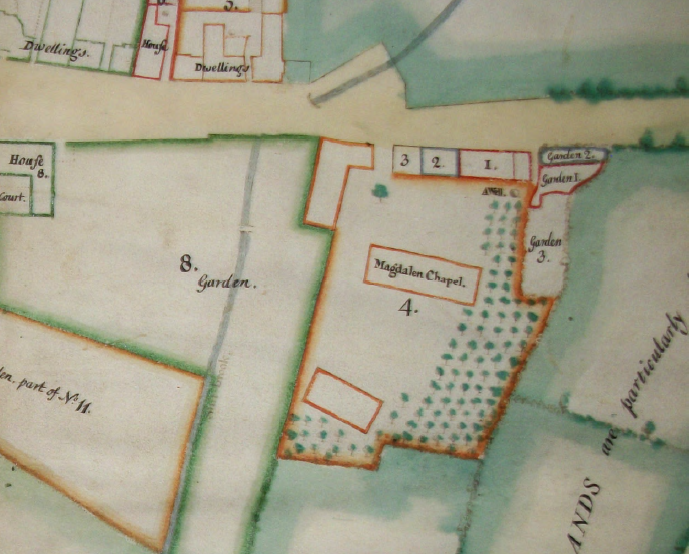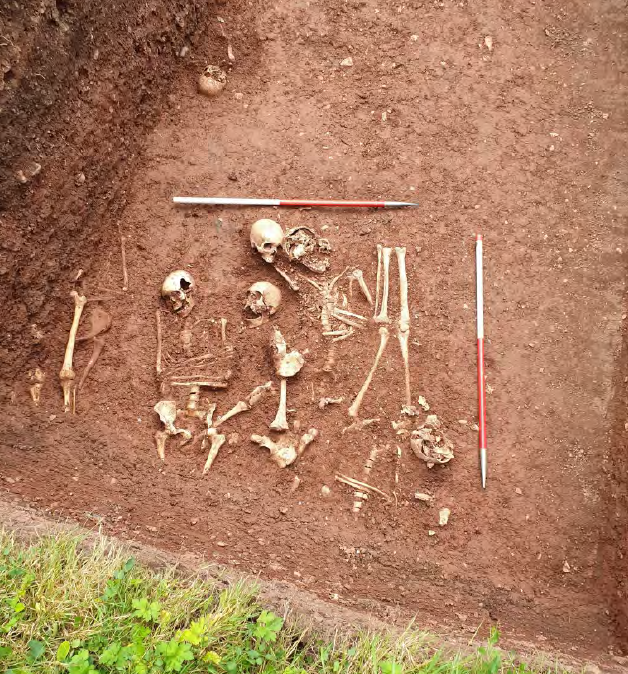Here’s a short summary of the results of an archaeological evaluation carried out by Oakford Archaeology at Hurst Almshouses, Fairpark Road, Exeter in June 2021. Remains of the medieval leper hospital were uncovered, including parts of the later graveyard and structural remains.
Oakford Archaeology carried out a desk based assessment in 2017 at Fairpark Road, Exeter. It highlighted a proposed development as the potential site of the medieval leper hospital.
An archaeological evaluation was subsequently carried out by Oakford Archaeology in June 2021 at the site. The work comprised the machine-excavation of 7 trenches totalling 33.62m in length, with each trench 1m wide. These were targeted on the buildings and the suspected line of the precinct wall shown on the historic mapping and provided a spatial sample of the site.

Trench plan showing principal features identified and proposed reconstruction of the hospital and poor house.
At the northern end of the site the remains of a robber trench were tentatively identified in Trench 7. This is perhaps the remains of the building shown on the 18th century map fronting onto Magdalene Road.

Detail from the 1746 Exeter Chamber map book showing the site before the construction of the new viaduct in the early 19th century.
In the centre of the site Trenches 2 and 3 exposed human remains. These were recorded in situ by a specialist osteoarchaeologist with regards to gender, age and pathologies (disease and cause of death). No bodies were removed and the remains were reinterred on completion of the archaeological work. The human remains consisted of a total of 12 individuals, including ten adults, one neonate (new-born) and one young infant (3-4yrs old), and although none exhibited skeletal changes due to leprosy all had evidence for extensive infections throughout their lives.
Based on limited archaeological information available from other leper hospital sites in England we know that about 60% of the skeletons excavated exhibited changes compatible with leprosy. The pathologies present in the small sample from Fairpark Road may have been caused by a wide variety of infectious diseases, whether the result of leprosy, tuberculosis or other chronic diseases, and it is unclear whether the remains are associated with the medieval leper hospital or the later poor house. The hospital was not dissolved at the Reformation and continued to exist, catering for the upkeep of some of the city’s poor until the late 19th century.
No structural remains of the chapel shown on 16th-19th century mapping were identified during the course of the works. To the south of the graveyard the remains of a heavily truncated medieval leat were identified in Trench 4. This would have provided clean water from further up the Shutebrook valley for the hospital, the kitchen and the latrines. Mortar floor surfaces both pre-dating and contemporary with the leat suggest the presence of at least one multiphase buildings in this area.
The deposits identified in Trench 5 are consistent with made ground deposits of mid to late 19th century date, while at the southern end of the site the site the ground was levelled in the late 19th century prior to the construction of a nearby row of terraced houses.
A small finds assemblage, consisting largely of pottery sherds dating to the 16th-19th centuries was recovered from the excavations, although a single Roman tegula or roof tile fragment and 18 medieval ridge- and floor-tile fragments were also uncovered.
The evaluation established important new evidence associated with the medieval Magdalene leper hospital and later poor house in the northern and central part of the site. The exact size and shape of the precinct and the buildings within is not known, although it is likely to extend beyond the limits of the excavations to the north and east. Based on present evidence it seems probable that in most areas, despite 19th and 20th century truncation, preservation is good with archaeological features and deposits preserved underneath the extensive landscaping that has taken place across the site.




Recent Comments